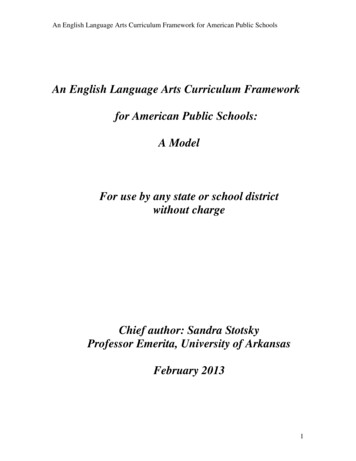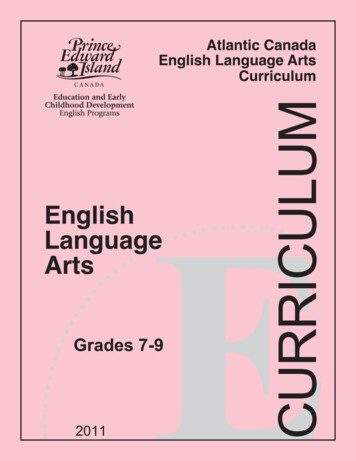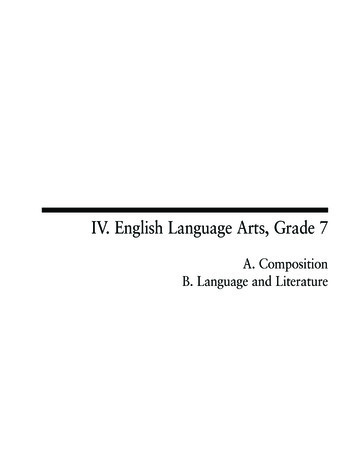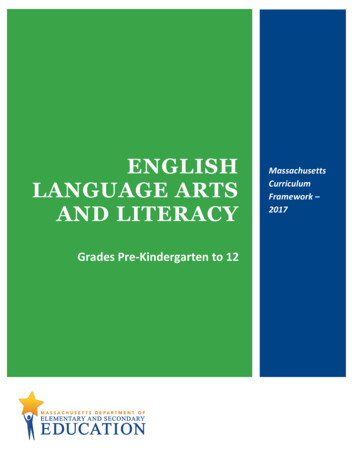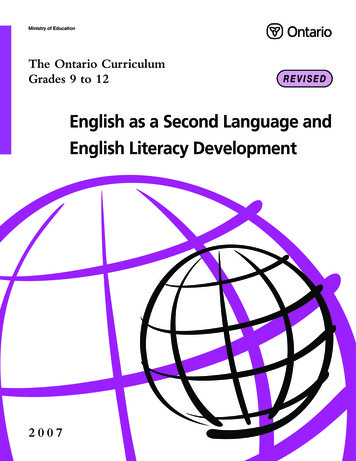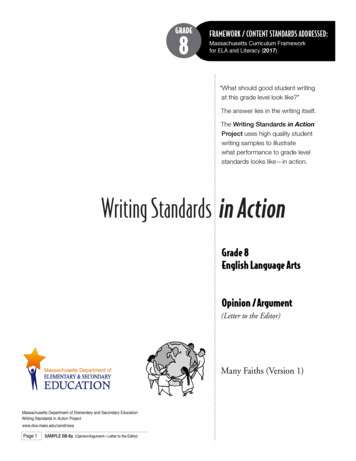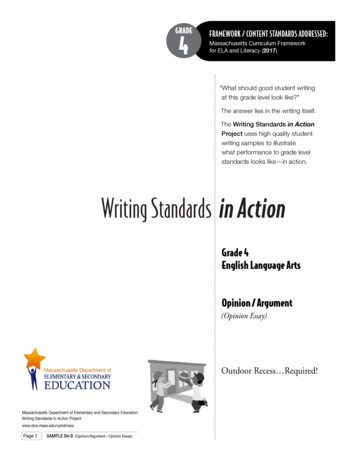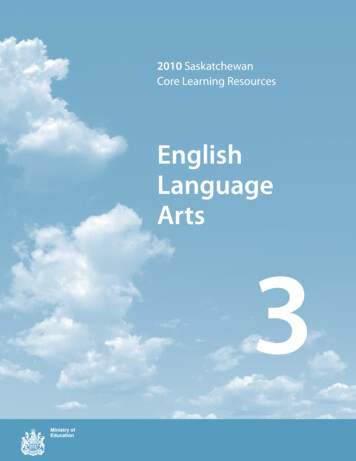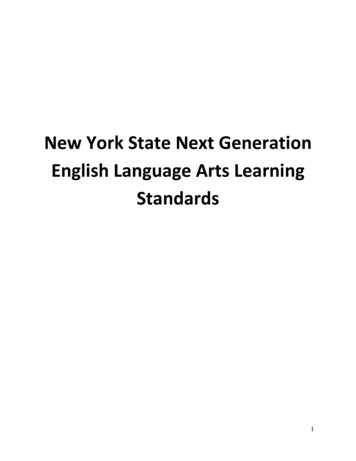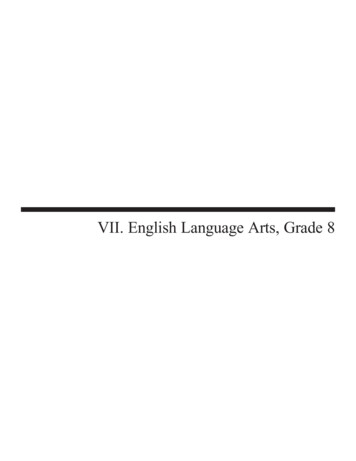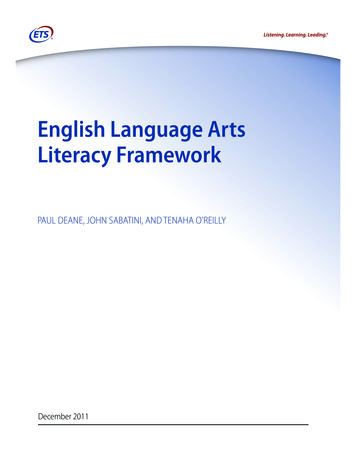
Transcription
English Language ArtsLiteracy FrameworkPAUL DEANE, JOHN SABATINI, AND TENAHA O’REILLYDecember 2011
1. INTRODUC TIONResults of the national reading report card show that too many of the nation’s students are failing to reachreading and writing proficiency by the end of high school, and they are lagging behind in grade-levelproficiency along the way (National Center for Educational Statistics [NCES], 2008, 2010, 2011). The K–12English language arts (ELA) Common Core State Standards (Council of Chief State School Officers &National Governors Association, 2010) were designed, in part, to set a trajectory ensuring that all studentsare college and career ready by no later than the end of high school. The Standards also are designed toencourage a comprehensive approach that coordinates reading, writing, speaking, and listening, not onlyin traditional ELA literature-based coursework, but also in the content areas of history/social studiesand science.In the course of elementary to secondary education and beyond, students must learn the specific skills toread, write, and thoughtfully engage in a wide variety of advanced literacy practices, and master all theprecursor skill foci (e.g., learning to read and write, writing a summary or book report, comprehending ortelling a narrative story, evaluating or constructing a reasoned argument) that eventually yield career- andcollege-level proficiency. However, skills cannot be taught all at once. Many skill foci grow in sophisticationover time, building on and integrating precursor skill foci. For example, students need to learn the elementsor grammar of a narrative story before they can interpret how characters’ goals and conflicts influence thedevelopment of the plot of a novel. Students need to be able to distinguish fact vs. opinion, pro vs. con, andclaim vs. evidence before they can assemble a sound, reasoned argument.The Standards articulate a general roadmap of goals and sequences for the ELA curriculum. However, theStandards were not intended to be the sole source for guiding instruction, learning, and assessment. Rather,we would want to inform, embellish, and elaborate on the Standards with sound, empirically based guidanceculled from some 40 years of learning sciences research. It is the goal of the CBAL (Cognitively BasedAssessment of, for and as Learning) initiative and the ELA competency framework described below toprovide that elaboration.TMThrough the CBAL initiative, the conceptual foundation has been laid for an integrated system in whichsummative assessments, formative assessments, and teacher professional support work together toencourage and enhance effective teaching and learning. According to its theory of action (Bennett, 2010),the CBAL system model is conceived as an education intervention. The theory of action guides assessmentdesign and validation, both in the evaluation of what scores mean and in the evaluation of the intendedimpact of the assessment system on individuals and institutions. The assessment designs themselves areguided by modern theories of learning and cognition (Quellmatz & Pellegrino, 2009). A key element of themodel is domain-specific competency models, as described next.2. WHAT IS A COMPE TENCY MODEL AND WHY IS IT IMPORTANT?In CBAL, domain-specific competency models are a strategy designed to integrate learning sciencesresearch with content standards. The competency models help not only in the specification of knowledge,processes, strategies, and habits of mind to be assessed, but also in identifying instructional-practiceprinciples for use in assessment design. Each model is derived from reviews of the learning sciencesliterature in mathematics and in English language arts (ELA) reading and writing. That literature speaks toboth student development and effective instructional practice. Recent versions of the models for middlegrade students can be found in Deane (2011), Graf (2009), and O’Reilly and Sheehan (2009). The modelsE N G L I S H L A N G UA G E A R T S L I T E R A C Y F R A M E W O R K2
have been linked to the Standards. They are continually refined via collaborations with teachers andclassroom pilot data as the CBAL project progresses through its multiyear research agenda.As noted, the Standards are important for setting appropriate targets for instruction, but they often remainabstract, too far removed from informing good instructional practice and specific assessment designs.Consequently, assessments that are defined solely with respect to the Standards run the risk of havinglimited instructional relevance, and may fail to account for results from decades of learning sciencesresearch that can serve as a principled guide to implementing sound instruction. In CBAL, an ELAcompetency model has been developed that integrates reading, writing, and the critical thinking processesthat are necessary to reach proficiency in the English language arts. Below we provide a brief outline of thecore concepts. A more comprehensive website can be found at http://elalp.cbalwiki.ets.org. The websitesystematically presents the full model, including a series of hypothesized progressions of skill foci thatunderlay ELA proficiency, along with the foundational research that guided their formulation.Here is a brief summary of the key features of the ELA model:1. A general framework that classifies literacy skills as reflecting three major modes of cognitiveprocessing (integrated processes that produce different end products, such as reading, writing,and thinking) and five major models of cognitive representation (distinguished by the kind ofconcepts and reasoning that they employ).2. A taxonomy of skill foci that, for each mode of cognitive processing and representation,identifies specific groups of skills and related strategies that (a) draw consistently upon a specifictype of cognitive skill, and (b) form the basis for particular types of literate activity systems.3. A series of provisional developmental levels that represent hypotheses about how studentsprogress across time towards high levels of skill.12.1 ELA Competency ModelThe research basis for CBLA ELA assessments was drawn from a variety of literatures, which emphasizethat literacy skills involve complex coordination of cognitive abilities at many levels of representation. Thepicture that emerges portrays reading and writing as sharing common representations and calling upon asimilar general architecture, but differing in detail both in the range of processes invoked and in how thoseprocesses are organized in time. Some literatures we reviewed consider writing primarily as text production,and reading as decoding and literal comprehension. Other literatures emphasize the purposeful, social,and institutional nature of reading and writing and highlight the way in which these skills support inquiryand critical thinking. There is broad consensus that literacy skills are most effectively acquired in contextsthat make reading and writing meaningful, in relation to both their content and to the social context withinwhich writing takes place (Alverman, 2002; Graham & Perin, 2007; Langer, 2001). These considerationssuggest a picture in which reading, writing, and critical thinking differ in purpose and emphasis yet draw ona common pool of literacy skills. This reasoning has led us to construct a literacy framework that applies toall three activities. Such a framework is critical if we hope to achieve the pedagogical goals expressed in theRace to the Top Assessment Program and other educational reform efforts.1 utside the English language arts, such progressions are often called “learning progressions” (Duncan & Hmelo-Silver, 2009). We use differentOterminology here primarily to avoid confusion because it is not clear in the current stage of research whether the developmental sequencesobserved with general literacy skills follow the same kinds of principles that may govern the learning of mathematical or scientific concepts.E N G L I S H L A N G UA G E A R T S L I T E R A C Y F R A M E W O R K3
2.2 Modes of Cognitive ProcessingIt is useful to distinguish from one another interpretive processes that enable fluent reading and textcomprehension, expressive processes that enable fluent composition and transcription, and deliberate(reflective) processes that support evaluation, strategic planning, and critical thinking.A simple view might equate interpretive processes with reading, expressive processes with writing, andreflective processes with critical thinking, but matters are more complex. Skilled readers write in support ofreading (by taking notes) and employ reflective reading strategies. Skilled writers use reflective strategiesto improve writing quality and read every time they revise or in response to material from other texts. It is acommonplace that skilled thinkers read and write to acquire information and clarify their thoughts, and thereis evidence that higher levels of performance are achieved when reading, writing, and critical thinking arecoordinated in instruction (Klein, 1999; Tierney, Soter, O’Flahavan, & McGinley, 1989). Thus, interpretive,expressive, and reflective processes take place, and interact, at many levels.As a first, rough approximation, interpretation corresponds to reading, expression to writing, anddeliberation to critical thinking and inquiry. However, in our view, this characterization seriouslyoversimplifies the picture. First, it leads to the misconception that cognitive processing is modality specific.One understands and interprets traditional print, visual graphics, video/film, multimedia, acts, events, andepisodes. In terms of the Standards, listening skills are closely aligned with reading skills in that bothare characterized as primarily about understanding and interpreting literacy information. Similarly, oneexpresses oneself by writing, speaking, acting on the world, creating multimedia, presenting visual graphics,etc. Essentially, for every interpretive form, there is a parallel expressive form, because we are both theconsumers and authors of literacy products. Also, cognitive processes that enter into interpretation orexpression typically require elements of deliberative/reflective thought to be performed proficiently. Someroutine operations (e.g., reading or typing words) may require less effortful deliberation or reflection, but atevery representation level (discussed next) of the ELA model there are deliberative and reflective operations.Clearly, at the high end of sophistication and performance, the deliberative, reflective, critical thinking skills,as well as their strategic coordination, are essential to effective performance.Simplifying the modes as reading, writing, and thinking, thus, runs the risk that teachers and learners mayfail to make the connections between listening, reading, and composing a story; between forming a coherentargument (a deliberative act) and expressing that argument in print (as in a persuasive essay), or evaluatingthe quality of a piece of persuasive writing (interpretive act). That is, we observe that in many contextsreading and thinking skills are used by expert writers. Similarly, we observe that in many contexts, writing(e.g., note taking) and thinking skills are used by skilled readers. And finally, in many contexts, readingand writing skills serve to support effective thinking. In fact, we would contend that the literature paints apicture in which different configurations of literacy skills are marshaled and deployed, depending on socialcontext and purpose.2 Thus, our integrated model serves as a reminder that the artificial segregation ofreading, writing, and thinking as modality-specific skill foci could introduce partitions in students’ literacyskill development that undercut the development of broader proficiency.2 An effective illustration of this concept, as it applies to the task of creating argumentative writing, can be found in Coirier, Andriessen, &Chanquoy (1999).E N G L I S H L A N G UA G E A R T S L I T E R A C Y F R A M E W O R K4
2.3 Models of Cognitive RepresentationWe distinguish five models of cognitive representation, each of which participates in interpretive,expressive, and reflective cognitive processes and involves distinct kinds of perception and reasoning: Social Model: Representation of and reasoning about people as social agents, focusing onsuch concepts as perspective, motivation, and purpose. Conceptual Model: Representation of and reasoning about abstract mental models, focusingon such concepts as categories, definitions, generalizations, and logical arguments. Discourse Model: Representation of and reasoning about texts, viewed as structuredsequences of rhetorical units. Verbal Model: Representation of and reasoning about linguistic form and content, viewedas meanings encoded by specific word choices and by the selection of specific syntacticstructures. Print Model: Representation of and reasoning about the relationship between linguisticform and its orthographic expression (e.g., spelling, decoding, typographical symbols,and related skills).In the remainder of this section, we will examine the basis for each and then discuss how these distinctionscan be leveraged to map out categories of literacy skill.The social model represents minds and social interactions among agents and supports comprehension ofsocial situations, interpretation of narrative, and formulation of communicative goals. It brings to bearelements of emotional intelligence (Mayer, Salovey, Caruso, & Sitarenios, 2001) and reflects the principlesof linguistic pragmatics (Mey, 2001; Ostman & Verschuren, 2005), which focus on how people readbetween the lines to infer intended and implicit, as opposed to explicitly stated, meanings. This skill thusfocuses on making inferences about intentionality, perspective, and affect (Zwaan, 1999, 2004). Some textfeatures indicate social elements, including voice, bias, point of view, tone, and stance. Inferences aboutcommunicative intent depend on an underlying theory of mind (Wellman, 1990; Wellman & Gelman, 1992),which is implicated in ordinary social situations, in fictional narrative situations (Mar, 2004; Mar, Djikic,& Oatley, 2008; Mar, Oatley, Hirsh, de la Paz, & Peterson, 2005), and when writers deal with audienceand purpose.The conceptual model supports the kinds of abstract reasoning processes that come under the headingsof categorization, logical inference, argumentation and causal reasoning. Because it involves recall andnot just concept formation, conceptual reasoning presupposes processes to access prior knowledge, whichis associated in turn with fluency of comprehension (Ericsson & Kintsch, 1995; McNamara & O’Reilly,2003) and text production (Cain, Oakhill, & Bryant, 2004; DeGroff, 1987; McCutchen, 2000). Effort putinto conceptual reasoning connects ideas, which improves comprehension (Brem & Rips, 2000), rewardseffort in processing hard-to-read texts (McDaniel, Hines, & Guynn, 2002; McNamara, Kintsch, Songer,& Kintsch, 1996), and improves writing quality (Hillocks, 1987). Recall and knowledge-based inferenceare, of course, relatively straightforward, falling low on scales of cognitive complexity of the sort notedby Bloom (1956).E N G L I S H L A N G UA G E A R T S L I T E R A C Y F R A M E W O R K5
The discourse model comprises the ability to model the propositional content of a text within a rhetoricalframe — in other words, to choose the right organizational structure and methods of development for thepurpose at hand, and to interpret a text in the light of the author’s choice of specific textual structures anddevices. There is a close connection between discourse modeling skills and genre. Genres are sociallydefined tools within an activity system, conventionalized methods that define characteristic rhetorical movesfor achieving standard communicative purposes (Swales 1990). Genres display characteristic organizationalpatterns (Donovan & Smolkin, 2002; Kamberelis & Bovino, 1999; Martin & Rose, 2006; Rose, 2006),conform to characteristic styles, and fall within conventional registers and patterns of word choice (Biber,1988, 1995; Biber & Conrad, 2001; Biber et al., 2004; Biber & Finegan, 1994). Not all discourse structureis explicitly cued. Much is inferred while building up a situation model, or representation of text content(Kintsch, 1988; van Dijk & Kintsch, 1983). Inference types include predictive inferences about what willcome next in a text, elaborative inferences connecting what is said to what one already knows, and bridginginferences that clarify why one statement should follow another (Clark & Haviland, 1974; Singer, 1994) thatestablish textual coherence (Kintsch, 1998). Inferences may be founded on social modeling or conceptualreasoning, but not all such inferences belong to the discourse model, only those that occur automatically formost readers (Long & Golding, 1993; Magliano, 1999; McKoon & Ratcliffe, 1992; Trabasso, 2005).The verbal model is based upon the mapping of form to meaning established by the grammar and lexicon ofa language. Verbal control in written texts initially derives from oral language (Shanahan, 2006), which displaysgradual increases in syntactic and lexical complexity. Strong oral language skills usually co-occur withstrong reading and writing skills (Loban, 1976), though see Shanahan (2006). But control of written discourserequires greater awareness of form and meaning than is usual in conversational contexts, and developsgradually across the school years (Berman, 2007). Written language also influences oral language development,particularly vocabulary (Anderson & Freebody, 1981; Beck & McKeown, 1991; Nagy et al., 2000).The print model represents skills in processing text in formal, phonological, or orthographic terms. Theseskills require phonological awareness, knowledge of orthography, mastery of prescriptive grammarrules, and control of typographical conventions. Mastery of print processing presupposes code-switchingabilities (since most written genres require standard English). For reading, print processing skills includedecoding (knowledge of sight-to-sound correspondences), orthographic conventions and word recognition(Berninger, Abbott, Billingsley, & Nagy, 2001; Perfetti, 1985), along with knowledge of how printed text(along with print cues like punctuation and italics) are parsed to approximate speech equivalents (Kuhn,Schwanenflugel, & Meisinger, 2010). For writing, print processing skills include spelling and wordrecall, knowledge of grammatical and mechanical conventions, and the like, along with the motor skillssupporting handwriting and typing — roughly equivalent to what Graham and Harris (2000) refer to astranscription skills.These five models correspond to key concepts in a variety of reading and writing theories. For instance,if we think in terms of Bereiter and Scardamalia (1987), the social model corresponds to their “rhetoricalproblem space” focused on solving problems involving communicative goals, and the conceptualmodel corresponds to their “conceptual problem space” focused on solving problems involving theconceptualization of content to be communicated. Similarly, viewed in terms of classic reading theory, theverbal and print models correspond to the two components of the simple view of reading (Hoover & Gough,1990), while the discourse model goes beyond the simple view to account for the necessity of constructingsituation models that include text macrostructure (Graesser, Singer, & Trabasso, 1994; Kintsch, 1998). Webelieve that these five models provide reasonably complete coverage of the classes of skills that play a roleE N G L I S H L A N G UA G E A R T S L I T E R A C Y F R A M E W O R K6
in literacy processes. We postulate that these models are implicated equally in reading, writing and thinkingprocesses, accounting for much of the commonalty across various forms of literacy.2.4. The MatrixThe most important thing to understand about our conception is that it describes an array of potential skillsthat may be engaged differentially (in different combinations, and in different sequences) for specificpurposes. The exact configuration of skills employed may vary both by task and by individual. Thus, in ourconception, the ELA construct includes both a broad base of competencies, which draw in turn upon welldeveloped arrays of skill foci (discussed in next section) that govern specific purposeful applications ofthese skills. Next we provide broad definitions of the five models and how they vary depending on cognitiveprocess (interpretive, expressive, and deliberative). (See Table 1.)Table 1. Range of Literacy Monitor/CorrectTranscribe3. SKILL FOCIAn account of literacy skill cannot stop by postulating a cognitive framework; instead, it needs toidentify specific literacy activities and the constellations of skills that recur over and over again inproficient performance, because those activities and constellations help to meet the demands of particularsocial institutions and correspond to recurrent communicative purposes and contexts. These recurrentconstellations define what we refer to as skill foci. The specific skill foci that we have identified are intendedto map to common literacy activities in which college- and career-ready citizens commonly are calledupon to engage — reading and understanding documents, books, websites; composing a communication,explanation, essay, or report — as well as the precursor forms that are developed across the K–12curriculum. As such, they largely correspond to skills typically targeted by educational standards such asthe Standards, and to the range of self-regulated strategies that have been identified as supporting effectivereading comprehension, writing, and critical thinking. They typically also correspond to specific genres ofreading and writing or to specific types of writing processes. (See Table 2.)E N G L I S H L A N G UA G E A R T S L I T E R A C Y F R A M E W O R K7
Table 2. Skill FociMODELSocialConceptualDiscourseVerbalPrintSKILL FOCISocial modeling, storytelling, close reading, stance-taking, code-switching, reconciliationof multiple perspectives, rhetorical analysis, standard-setting, appeal-buildingSelf-explanation, exposition, clarification, inquiry, appropriation of ideas, research synthesis,hypothesis-testing, argument-buildingOutlining/summarizarion, structured expression, prediction, planning, comparison,incorporation, (p)review, revisionVerbal inference, verbal expression, vocabulary development, glossing and paraphrase,grammatical analysis, sentence-combining, editorial mark-up, line-editingSound-out (phonics), memorization (sight-reading), analogy (word-families), look-up,print cues, prescription, self-correction, proofingIn our analysis, these skill foci enable us to map literacy skills onto what is known about cognitive and skillsdevelopment. The sets that we have identified include print-level skills such as proofreading, discourse-levelskills such as paraphrase, conceptual skills such as argumentation, and social reasoning skills such as thoseinvolved in the management of stance and perspective. These skill foci typically crosscut reading, writing,and critical thinking, especially at the more sophisticated levels of performance. Table 2 lists and brieflydefines skill foci that we have identified or hypothesized based on examination of school curricula andlearning sciences research literatures.As illustration, we provide the following example of well-established literacy activities that are ubiquitousin curriculum, instruction, and assessment: writing persuasive essays.Applying the cognitive framework, we first note that a persuasive essay can be conceived as an admixtureof forming (deliberative) and composing (expressive) a sound argument (conceptual model) and buildingappeal in an audience (social model). In addition, a persuasive essay typically requires command andunderstanding of a particular rhetorical text structure (discourse model), which entails the appropriate use(verbal model) of academic argumentation terms (e.g., therefore, ergo, contends, claims). One can envisiona writing task that is focused solely on appeal building (e.g., an advertisement), absent argumentation.Analogously, one can formulate and express an argument soundly without the side condition of buildingappeal. In fact, the two conditions can be in direct conflict. Insulting or belittling one’s adversary often isused as a technique to build appeal, but it also may be viewed as an ad hominem attack, weakening theargument. Analogously, one can compose a sound argument, but write in a style that is condescending orpompous, alienating versus persuading one’s audience to agree with one’s position. Finally, one can evaluatestudent essays using a rubric that awards points primarily for the accuracy of the spelling, grammar, andvocabulary usage and adherence to the expected rhetorical structure and organization, all but ignoring thequality of the argument or the effectiveness of the appeal.In analyzing a range of existing persuasive essay assessment prompts, we contend that these promptsfall arbitrarily and unevenly into different categories, depending on whether students are evaluated onE N G L I S H L A N G UA G E A R T S L I T E R A C Y F R A M E W O R K8
the quality and soundness of their argument, the effectiveness by which they build appeal, or simply theaccuracy with which they deploy the appropriate rhetorical structure or form (i.e., a five-paragraph essay inwhich the opening paragraph states a position, and three claims are backed up by factual statements).With respect to instruction, we observe that there are several constellations of skill foci nested in skillfulpersuasive essay writing. For instance, students need to develop an understanding of argumentation (thoughthis is not the only skill required, as our discussion already indicates). The development of argumentationskills may include a purely deliberative instructional approach (e.g., group discussions in which everyonebuilds a verbal argument for or against a position, debating facts and claims). One also can imagine askingstudents to identify and evaluate arguments in editorials or essays, before asking them to compose theirown. In CBAL, we have developed a formative sequence of concepts and skills that support the buildingof students’ argumentation skills (Deane, Fowles, Baldwin, & Persky, 2011). Appeal building also can bedeveloped, though not necessarily simultaneously with argumentation skills. In our analysis of advancedpersuasive academic essay writing, we have observed the value and utility of students being able to drawupon such precursor skills as summarization and thesis writing. Summarization skills, for example, helpstudents to evaluate supporting documents or opposing arguments, then use the results in composing theirown positions.This exercise of analyzing literacy activities and accompanying skill foci in terms of the conceptualframework enables us to integrate empirical learning theory into assessment designs and to connectthem explicitly with instructional goals at a specific grade or skill level. It also has led us to hypothesizedevelopmental sequences as we identify the dependences among skill foci in performing increasinglycomplex and sophisticated literacy activities across the elementary, middle, and secondary school years.We discuss these provisional sequences next.4. HYPOTHESIZED DE VELOPMENTAL SEQUENCESThe final element in the ELA literacy model is the specification of hypothesized developmental sequences.These reflect known developmental information where available; thus, our account of narrative reflects thework of Nicolopolou and colleagues (Nicolopoulou, 1997, 2002) and McKeough (2007). Similarly, ouraccounts of the development of argumentative writing partially reflect the research of Kuhn and colleagues(Felton & Kuhn, 2001; Kuhn, 1999; Kuhn & Udell, 2003). In other cases, the research literature is less clear,and we have had to glean information from various sources, including curricula and standards, in order tobuild a provisional model. Thus, we characterize the developmental sequences as hypotheses to be verifiedand revised as research proceeds.An illustrative sequence can be drawn from our hypothesized developmental sequence for argumentation.At relatively simple skill levels, arguers must generate plausible reasons to support a claim or infer when anargument supports or opposes a claim. At higher levels of performance, they must be able to differentiatearguments according to their soundness and assess whether specific evidence helps to strengthen or weakenan argument. The highest levels of performance require students to perform such critical reasoning tasksas identifying and questioning warrants or building and assessing counterarguments. We can think of thetransition between levels in the progression conceptually, as involving a sequence like the following:1. Conflict. The minimum prerequisite for rational argument is the recognition of incompatibleand conflicting viewpoints. Argument begins with disagreement, even if it is disagreement aboutunsubstantiated opinions. The process fundamentally involves dialog: one person making a claim,E N G L I S H L A N G UA G E A R T S L I T E R A C Y F R A M E W O R K9
another person disagreeing, and the first person providing some kind of justification. At this stage, theremay be little understanding of logic, or of anyone else’s point of view; but the arguer is at least aware ofa need to respond.2. Justification. Having learned that challenges must be answered, the arguer can begin to anticipatecha
Simplifying the modes as reading, writing, and thinking, thus, runs the risk that teachers and learners may fail to make the connections between listening, reading, and composing a story; between forming a coherent argument (a deliberative act) and expressing that argument
